Thursday Jan 16, 2025
Thursday Jan 16, 2025
Saturday, 23 May 2015 00:05 - - {{hitsCtrl.values.hits}}
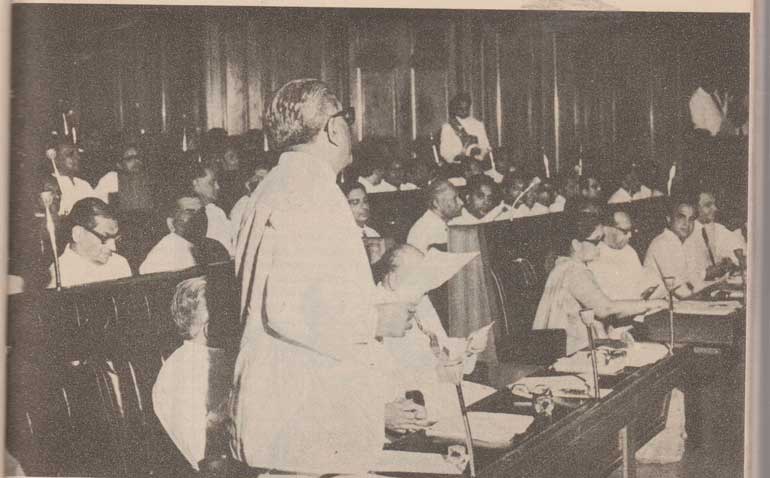
Constitutional Affairs Minister Dr. Colvin R. de Silva presents the final draft for adoption
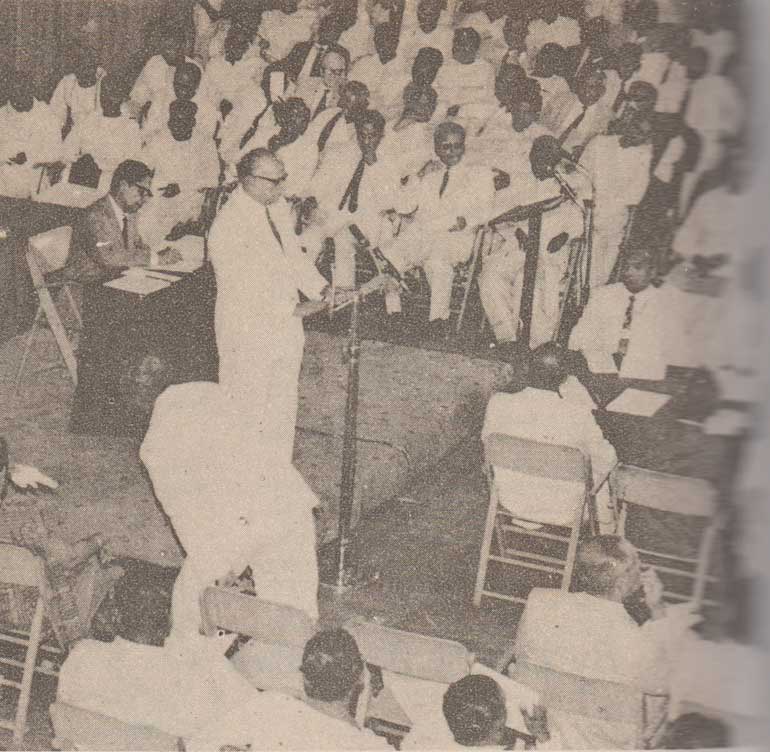
Dr. N.M. Perera addresses the first session of the Constituent Assembly
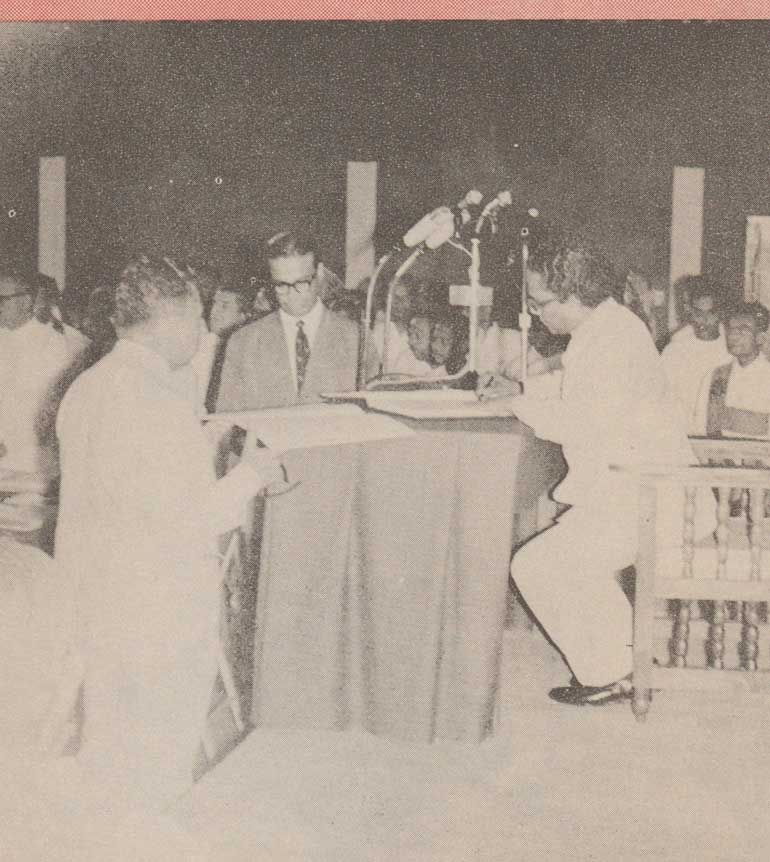
President of the Constituent Assembly Stanley Tillekeratne signs the document
By D.C. Ranatunga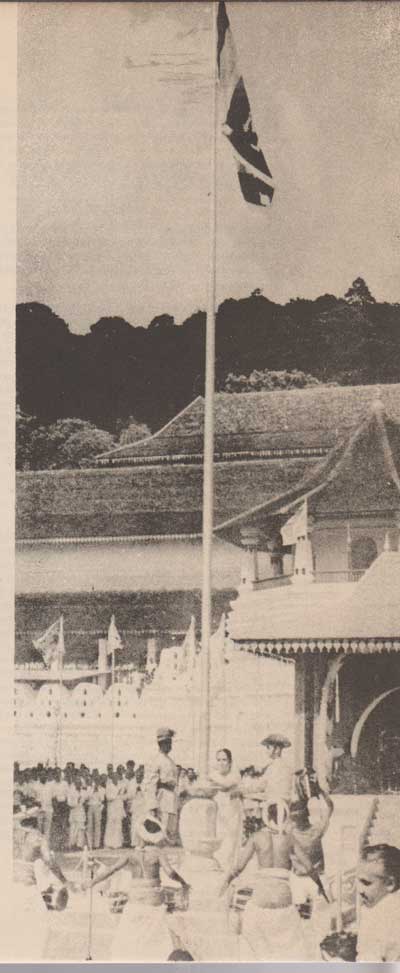
It’s 12:43 in the afternoon on 22 May 1972. A colourful ceremony is being held at the Navarangahala, Colombo. The Speaker of the House of Representatives Stanley Tillekeratne in his capacity as Chairman of the Constituent Assembly signs and certifies a new Constitution for the country.
Ceylon becomes ‘Sri Lanka’. A Constitution declaring Sri Lanka “a Free Sovereign and Independent Republic pledged to realise the objectives of a Socialist Democracy” is promulgated. The country remains a unitary state. It’s the dawn of a new era.
A promise made to the people by the United Front at the general election held in May 1970 was fulfilled. “We seek a mandate to permit the Members of Parliament you elect to function simultaneously as a Constituent Assembly to draft, adopt and operate a new Constitution. This Constitution will declare Ceylon to be a free, sovereign and Independent Republic pledged to realise the objectives of a Socialist Democracy, and will also secure fundamental rights and freedoms of all citizens,” the Joint Election Manifesto of the United Front (UF) stated.
The UF comprised the Sri Lanka Freedom Party (SLFP), the Lanka Sama Samaja Party (LSSP) and the Communist Party (CP), which won the general election convincingly.
Finally, an independent socialist republic
The first meeting of the Constituent Assembly was held at the Navarangahala on 19 July 1970. Prime Minister Sirimavo Bandaranaike moved the resolution that the Members of Parliament form themselves into a Constituent Assembly to enact a new Constitution.
In her address, she said that the Constituent Assembly and the Constitution that would be drafted would derive their authority from the People of Sri Lanka and not from the power and authority assumed and exercised by the British Crown and Parliament, as it did earlier.
Expressing “a personal expression of happiness”, she said that she felt proud to be able to begin “the fulfilment of one of the most cherished aims of my husband, the late S.W.R.D. Bandaranaike who, when he was Prime Minister, set himself the goal of making Sri Lanka an independent socialist republic.”
Culmination of struggles, trials and tribulations
Seconding the resolution, Finance Minister Dr. N.M. Perera said that the day marked the culmination of a long series of struggles, trials and tribulations that the country had gone through over the years. “Let us not forget that we have not reached this day ambling along smoothly from one election result to another,” he stated.
He remembered the martyrs who sacrificed their lives for the cause of liberty and independence, including Gongalagoda Banda, Puran Appu, Ven Kudapola and Ven Wariyapola Sumangala. He also referred to the role played by Anagarika Dharmapala and other leaders of the more recent past, and also great poets like Ven. Mahinda of Tibet, Ananda Rajakaruna and others who “fired the imagination of every peasant in his home and kept the fire of liberty kindled and alive”.
“Little did we as students in London meeting in dingy digs dream, when we inaugurated a movement that blossomed later to be the Lanka Sama Samaja Party, that we would within our lifetime be the proud participants of this historic day. We affirmed as our first principle on that distant day in 1930 the achievement of full national independence. It is the fulfilment of this affirmation that gives us unending pride and pleasure,” he added.
Referring to the task ahead, he said that no people can build entirely a new Constitution. “All of us are circumscribed by our own past, of social habits and inclinations. In a multi-national society such as ours, with different religions and different cultures, we have to fashion instruments of lasting amity and foster an atmosphere that will nourish the common bonds of national unity.”
All laws in Sinhala
To Constitutional Affairs Minister Dr. Colvin R. de Silva, one of the features that strengthened the democratic functioning of the Constitution most was the provision relating to language. “All laws shall be enacted or made in Sinhala. There shall be a Tamil translation of every law so enacted or made,” said the provision.
Dr. de Silva pointed out that the provision that completely displaced English in the law-making process goes to the root of independence and is the necessary instrument of the sovereignty of the people whose languages are Sinhala in the main and Tamil for the remainder. Law provides the framework of a society’s functioning and the language of the law determines the mode of such functioning.
The committees
The Constitution Drafting Committee under the chairmanship of Minister Dr. Colvin R. de Silva comprised Advocate H.L. de Siva, Cabinet Affairs Director and Secretary to the Cabinet M.S. Alif, Senior Crown Counsel Noel Tittawella and R.S. Wanasundera, Additional Legal Draftsman O.M. de Alwis, Permanent Secretaries to Ministries E.W.P.S. Jayawardena (Constitutional Affairs), Nihal Jayawickrema (Justice), Somasara Dissanayake (Information and Broadcasting) and Doric de Sousa (Plantations Industries), Additional Permanent Secretary M. Shanmuganathan (Constitutional Affairs), and lecturers J.A.L. Cooray (Law College) and Dr. P.E.E. Fernando and Dr. Shelton Kodikara (University of Ceylon). H.P. Jayatilleke was the stenographer.
There was also a Cabinet Committee on Constitutional Affairs, of which Prime Minister Sirimavo Bandaranaike was the Chairperson. Ministers Dr. Colvin R. de Silva, Maithripala Senanayake, Dr. N.M. Perera, Pieter Keuneman, Badi-ud-din Mahmud, T.B. Ilangaratne, Felix R. Dias Bandaranaike, T.B. Tennakoon, George Rajapakse, T.B. Subasinghe and Hector Kobbekaduwa and a number of officials served on the Committee.
There were 11 Sub-Committees of the Constituent Assembly, mainly to discuss with religious and other leaders, civil society organisations and the general public. These Committees held 114 sittings and went through nearly 3,000 memoranda from the public.
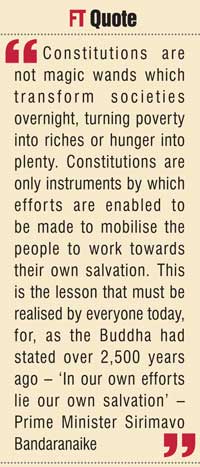
Taking oaths
After the promulgation of the Constitution, Sirimavo Bandaranaike took oaths as the first Prime Minister of the Republic of Sri Lanka. Governor-General William Gopallawa took the oath of office as the first President, inspected a Guard of Honour, hoisted the National Flag and got the blessings of the Maha Sangha at the President’s House.
The Prime Minister inaugurated the sale of the ‘Janarajaya’ 15-cent stamp at the General Post Office. She then came across to the Cabinet Office, received the blessings of the Maha Sangha and presided over the Republic’s first Cabinet meeting.
The members of the House of Representatives took oaths as members of the National State Assembly (NSA) which replaced the House of Representatives. Speaker Stanley Tillekaratne was conducted to the Speaker’s Chair by Leader of the House Maithripala Senanayake and Leader of the Opposition J.R. Jayewardene to preside over the first meeting of the NSA.
The ceremonies in Colombo ended with a cultural pageant.
Address to the nation
Two days later, after worshipping the Sri Dalada, the sacred Tooth Relic, Prime Minister Sirimavo Bandaranaike addressed the nation at the historic Maha Maluwa opposite the Dalada Maligawa.
She concluded her address saying: “Constitutions are not magic wands which transform societies overnight, turning poverty into riches or hunger into plenty. Constitutions are only instruments by which efforts are enabled to be made to mobilise the people to work towards their own salvation. This is the lesson that must be realised by everyone today, for, as the Buddha had stated over 2,500 years ago – ‘In our own efforts lie our own salvation’.”